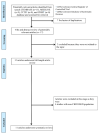Contrast-Induced Encephalopathy in Patients with Chronic Kidney Disease and End-Stage Kidney Disease: A Systematic Review and Meta-Analysis
- PMID: 37623810
- PMCID: PMC10456913
- DOI: 10.3390/medicines10080046
Contrast-Induced Encephalopathy in Patients with Chronic Kidney Disease and End-Stage Kidney Disease: A Systematic Review and Meta-Analysis
Abstract
Background: Contrast-induced encephalopathy (CIE) is an infrequent but serious neurological condition that occurs shortly after the administration of contrast during endovascular and angiography procedures. Patients suffering from chronic kidney disease (CKD) or end-stage kidney disease (ESKD) are considered to be at a higher risk of contrast medium neurotoxicity, due to the delayed elimination of the contrast medium. However, the occurrence and characteristics of CIE in CKD/ESKD patients have not been extensively investigated. Methods: We conducted a comprehensive literature search, utilizing databases such as MEDLINE, EMBASE, the Cochrane Central Register of Controlled Trials, and the Cochrane Database of Systematic Reviews, up to September 2022. The purpose was to identify documented cases of CIE among patients with CKD or ESKD. Employing a random-effects model, we calculated the pooled incidence and odds ratio (OR) of CIE in CKD/ESKD patients. Results: Our search yielded a total of eleven articles, comprising nine case reports and two observational studies. Among these studies, 2 CKD patients and 12 ESKD patients with CIE were identified. The majority of the CKD/ESKD patients with CIE (93%) had undergone intra-arterial contrast media and/or endovascular procedures to diagnose acute cerebrovascular disease, coronary artery disease, and peripheral artery disease. The male-to-female ratio was 64%, and the median age was 63 years (with an interquartile range of 55 to 68 years). In the two observational studies, the incidence of CIE was found to be 6.8% in CKD patients and 37.5% in ESKD patients, resulting in a pooled incidence of 16.4% (95% CI, 2.4%-60.7%) among the CKD/ESKD patients. Notably, CKD and ESKD were significantly associated with an increased risk of CIE, with ORs of 5.77 (95% CI, 1.37-24.3) and 223.5 (95% CI, 30.44-1641.01), respectively. The overall pooled OR for CIE in CKD/ESKD patients was 32.9 (95% CI, 0.89-1226.44). Although dialysis prior to contrast exposure did not prevent CIE, approximately 92% of CIE cases experienced recovery after undergoing dialysis following contrast exposure. However, the effectiveness of dialysis on CIE recovery remained uncertain, as there was no control group for comparison. Conclusions: In summary, our study indicates an association between CIE and CKD/ESKD. While patients with CIE showed signs of recovery after dialysis, further investigations are necessary, especially considering the lack of a control group, which made the effects of dialysis on CIE recovery uncertain.
Keywords: chronic kidney disease (CKD); contrast medium neurotoxicity; contrast-induced encephalopathy (CIE); dialysis and CIE recovery; end-stage kidney disease (ESKD).
Conflict of interest statement
The authors declare no conflict of interest.
Figures


Similar articles
-
Adverse Pregnancy Outcomes and Long-term Maternal Kidney Disease: A Systematic Review and Meta-analysis.JAMA Netw Open. 2020 Feb 5;3(2):e1920964. doi: 10.1001/jamanetworkopen.2019.20964. JAMA Netw Open. 2020. PMID: 32049292
-
Bidirectional association between chronic kidney disease and sleep apnea: a systematic review and meta-analysis.Int Urol Nephrol. 2021 Jun;53(6):1209-1222. doi: 10.1007/s11255-020-02699-1. Epub 2020 Nov 5. Int Urol Nephrol. 2021. PMID: 33155087
-
Prevalence and risk factors of peripheral artery disease in a population with chronic kidney disease in Australia: A systematic review and meta-analysis.Nephrology (Carlton). 2021 Oct;26(10):798-808. doi: 10.1111/nep.13914. Epub 2021 Jun 28. Nephrology (Carlton). 2021. PMID: 34156137
-
Comparison of health literacy profile of patients with end-stage kidney disease on dialysis versus non-dialysis chronic kidney disease and the influencing factors: a cross-sectional study.BMJ Open. 2020 Oct 29;10(10):e041404. doi: 10.1136/bmjopen-2020-041404. BMJ Open. 2020. PMID: 33122326 Free PMC article.
-
Progression to end-stage kidney disease in Japanese children with chronic kidney disease: results of a nationwide prospective cohort study.Nephrol Dial Transplant. 2014 Apr;29(4):878-84. doi: 10.1093/ndt/gfu012. Epub 2014 Feb 9. Nephrol Dial Transplant. 2014. PMID: 24516225
Cited by
-
Non-convulsive Status Epilepticus as a Potentially Under-recognised Cause of Consciousness Disturbance Following Mechanical Thrombectomy: A Case Report.NMC Case Rep J. 2024 Dec 25;11:407-411. doi: 10.2176/jns-nmc.2024-0181. eCollection 2024. NMC Case Rep J. 2024. PMID: 39850772 Free PMC article.
-
Severe contrast-induced encephalopathy diagnosed with postmortem dual-energy CT in an elderly patient.Radiol Case Rep. 2025 Jan 17;20(4):1877-1881. doi: 10.1016/j.radcr.2024.12.065. eCollection 2025 Apr. Radiol Case Rep. 2025. PMID: 39897761 Free PMC article.
-
Clinical Characteristics of Contrast Leakage and Contrast-Induced Encephalopathy Following Endovascular Treatment for Unruptured Intracranial Aneurysm.J Neuroendovasc Ther. 2024;18(11):287-292. doi: 10.5797/jnet.oa.2024-0042. Epub 2024 Sep 21. J Neuroendovasc Ther. 2024. PMID: 39568987 Free PMC article.
-
Contrast-Induced Encephalopathy: A Case Series Analysis.Ann Indian Acad Neurol. 2024 Jul 1;27(4):403-407. doi: 10.4103/aian.aian_548_24. Epub 2024 Aug 22. Ann Indian Acad Neurol. 2024. PMID: 39196808 Free PMC article.
References
Publication types
LinkOut - more resources
Full Text Sources

